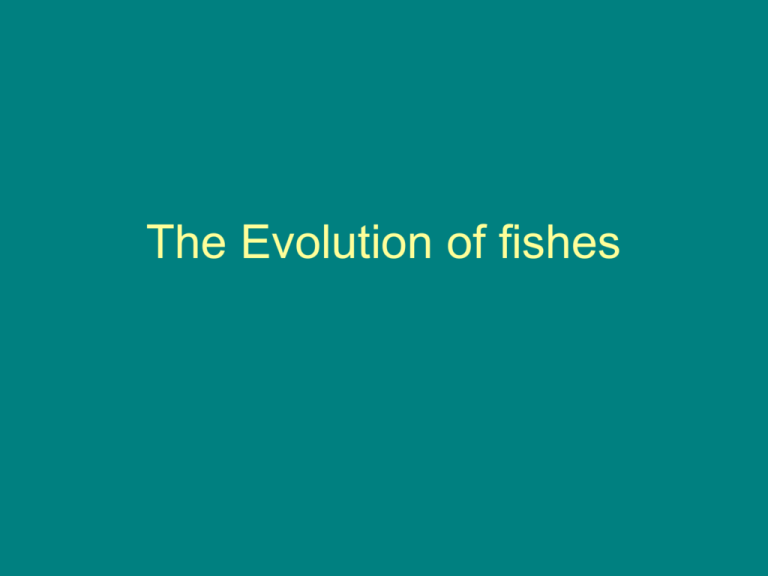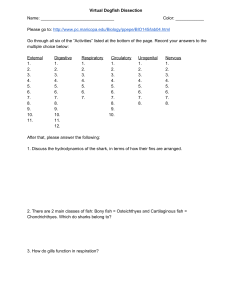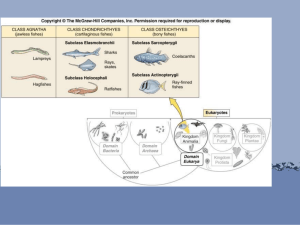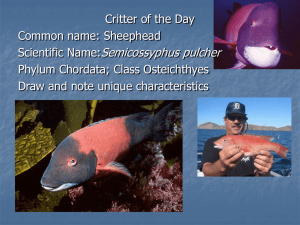Evolution of Fishes
advertisement

The Evolution of fishes How to become a better fish • Add paired appendages • Better tail (symmetrical) • Add jaws • Loose the armor • Strengthen internal skeleton Adding jaws 1. Clearly from gills 2. Mouth lined with ectoderm 3. Movement of markers: nasal opening, 4. Why jaws= value? 5. How can you get rid of a gill if gills are useful? = structural improvement 6. Note: teeth over much of mouth = ectoderm, same structure as dermal armor = bone, dentine, enamel. Jaw types and jaw structure primitively; cartilagenous inner structure = gill bar Outer structure = dermal armor Paired appendages 1. Why? – stabilize swimming 2. some primitive forms with fin fold Acanthodians = primitive bony fish with spines for fins, more than 2 pair primitively. Advanced fish – 2 pairs of fins (why two?? Functions?) Ray fin structures – found in all sharks, skates, rays. Bony fish skeletons Actinopterygians = ray fins Note change in position of pelvic Fin pair. Why?? Crossopterygian or sarcopterygian: bony fish with a fleshy fin = central bone elements and muscle with a ray fringe. Note fleshy fin types: Symmetrical = lungfish Assymetrical = crossopterygians (extinct) And coelacanth – marine living Primitive: heterocercal tail Advanced bony fish = homocercal = symmetric Placoderms Head and shoulder armor Primitive bony fish = Amia fairly solid outer skull. Advanced bony fish Skull reduced to barin case, jaw and gill supports – no heavy outer armor. Fish scales Primitive = ganoid = bone and enamel form a tile mosaic- solid. Placoid = similar but isolated in sharks Cycloid, ctenoid = reduced = thin, light weight. Material of the internal skeleton Old view – since cartilage replaced by bone, cart fish are older, gave rise to bony fish New view – Placoderms, with external bony armor and internal cartilage, arise from Agnatha – Both bony and cartilagenous fish arise from placoderms So: make sense out of it for classification 1. How to strengthen skeleton and lighten skeleton bony fish = osteichthyes – turn internal cartilagenous skeleton into bone for greater strength, and lighten external armor cartilagenous fish = chondrichthyes – keep internal cartilagenous skeleton, but add some calcium salt, turn external armor into ‘denticles’ = tooth like scales note; teeth = denticles in mouth. So Placoderms = armored = ancestral Notochord – jelly filled, hydrostatic skeleton cartilage Chondrocytes Matrix of collagen Haversian system Haversian canal Osteocyte (lacunae, space where cell is) Canaliculi Matrix is hydroxyapatite + collagen Typical bone Origin of bone by replacement of cartilage Origin of intermembranous bone = direct ossification in tissue, no cartilage precursor Fish- placoid scale Enamel on outside = solid Dentine inside = has canals Bone at base = canals and cells Chondrichthyes sharks, skates, rays and ratfish (Chimaera) Ratfish weird = no scales, mollusc eaters, deep sea, not too closely related Bony fish Four fin types: ray fin spine fin flesh fin – symmetrical flesh fin - assymetrical






